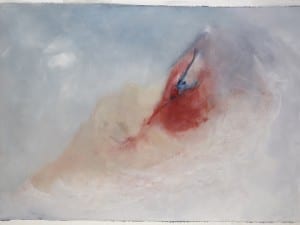Cynics may say the art fair is always a kind a crime scene, where culture is mercilessly sold as commodity in the service of capitalism rather than enlightenment. Asli Çavuşoğlu’s Murder in Three Acts (2012) is a thrilling allegorical exploration of this theme, which has its UK premiere just as the crowds gather for the madness of Frieze Art Fair.
Çavuşoğlu took up a residency at the Delfina Foundation in partnership with Frieze Projects 2012 to create a fast-paced crime drama in the style of CSI that follows three detectives as they unpack the mystery of a bloody murder in an exhibition space. Each of the three episodes were performed live and filmed at Frieze, so the finished film is in fact the second instalment of a project that began as a dramatic intrusion into the fair.
The Delfina Foundation’s HQ in Victoria, as a fortuitous matter of contingency, is a sublime setting for the showing of this film. The building is currently undergoing a major renovation so that all remains is the empty interior of a town house, entirely gutted and roughly painted white. The eerie shabbiness of the building site is like a crime scene itself, where visitors have to make their way up rickety staircases and into darkened rooms to gradually unpick the narrative. And everywhere audiences are haunted by the film’s soundtrack, which is at once jarring and captivating, speaking of tension and mystery.
Çavuşoğlu has managed to capture, with only a hint of good-humoured melodrama, the style of television crime dramas with such finesse that it is hard to see whether she is aiming for parody or homage. This contextual uncertainty draws the viewer into the narrative without worrying about style so much as being effectively captivated by the immense substance. At the core of Murder in Three Acts there is a highly complex and dramatically charged allegory between murder and art or crime scene investigation and textual interpretation. The artwork is suspected to be the murder weapon, so that it is subjected to a forensic analysis, becoming a very different kind of text; and the exhibition space itself is the scene of a brutal murder, blurring a line between performance art and live atrocity. An interactive installation, seen only with UV lights in a dark room, recreates the chilling blood-splattered walls in the film, placing the audience at the gruesome centre of the drama.
Murder in Three Acts has only a surface level of meaning as a crime drama, but it is really a cutting and extraordinarily erudite commentary on the way the artworld imposes meaning upon objects. It draws a parallel between building a collection of art and gathering a body of evidence, analysing how the artwork becomes meaningless the moment it is implicated in a real life situation. As a piece of cinematic drama, it is crisp, slick and well-made, but as a critique of the artworld it is an edifying call to see the gallery, museum or fair as a scene of some unseen, urgent misdemeanour.
Asli Çavuşoğlu: Murder in Three Acts, until 25 October, Delfina Foundation, 29/31 Catherine Place, Victoria, London SW1E 6DY.
Daniel Barnes
Credits
1. Asli Çavuşoğlu, Murder in Three Acts, 2012. Performance view, Frieze Art Fair 2012, Commissioned and produced by Frieze Projects 2012. Courtesy of the artist and Gallery NON, Istanbul. Photo: Taylan Mutaf.





